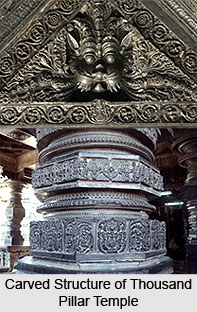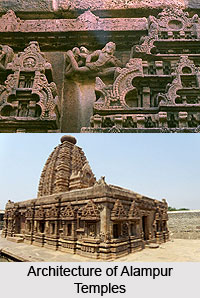 Architecture in Telangana covers the monuments that were built in the later half of 10th Century to 12th Century. In this time, the Chalukyas and Kakatiyas rule the region which is now known as Telangana, the newly formed state in India with Hyderabad as its capital.
Architecture in Telangana covers the monuments that were built in the later half of 10th Century to 12th Century. In this time, the Chalukyas and Kakatiyas rule the region which is now known as Telangana, the newly formed state in India with Hyderabad as its capital.
During the rule of Kakatiya Dynasty and the Chalukyas of Badami, the art and architecture of Telangana reached at its height. In this time, some of the architectural monuments like Thousand Pillar Temple, Alampur Temples, Ramappa Temple and many other temples. The temples of Telangana and the forts like Warangal Fort and Bhongir Fort were built during the time of Nizams and Mughals. During the rule of Golconda Kings, the Golconda fort was made where one can see the excellence of artistic beauty of Mughal times.
Carved Pillar at Thousand Pillar Temple
Thousand Pillar Temple is one of the very old temples of South India located in Telangana. This temple was built during the rule of Kakatiya Dynasty of Warangal. It stands out to be a masterpiece and achieved major heights in terms of architectural skills by the ancient Kakathiya Vishwakarma Sthapathis. The carved pillar of Thousand Pillar Temple is the example of Kakatiya Art. It is believed that Thousand Pillar Temple was built by King Rudra Deva in 1163 AD. Thousand Pillar Temple is a specimen of the Kakatiyan style of architecture of the 12th century. It was destroyed by the Tughlaq dynasty during their invasion of South India. It consists of one temple and other building. There are one thousand pillars in the building and the temple, but no pillar obstructs a person in any point of the temple to see the god in the other temple.
 Temples of Alampur
Temples of Alampur
There are a total of nine temples in Alampur. These temples are the example of rich architecture of Chalukya times. All of them are dedicated to Lord Shiva. These temples date back to the 7th century A.D. These temples were built by the Badami Chalukya rulers who were great patrons of art and architecture. Even after a time span of several hundred years, these grand temples still stand firm reflecting the rich architectural heritage of the country. The temples are symbolic features of the Northern and Western Indian styles of architecture. They do not reflect the Dravidian style of architecture as is generally common with the temples in this region. The shikharas of all these temples have a curvilinear form and are adorned with the miniature architectural devices. The plans and decoration similar to that of the rock cut temples. Alampur Navabhrama Temples are historically important and reflect remarkable architectural skills.
Warangal Fort
Warangal Fort appears to have existed since at least 13th century CE. This fort was built during the time of later half of Kakatiya rule. Warangal Fort was build during the time of Rudramadevi and Prataparudra. Warangal Fort had the gateways, square bastions and additional circular earthen walls prior to the death of Prataprudra n 1323.
Salar Jung Museum
Salar Jung Museum is the carrier of Indian art of Nizam rule. Salar Jung Museum is an art museum located at Darushifa, on the southern bank of the Musi River in the city of Hyderabad. The collection of the museum was sourced from the property of Salar Jung family. Salarjung Museum is the third largest museum in India housing the biggest one-man collections of antiques in the world.



















